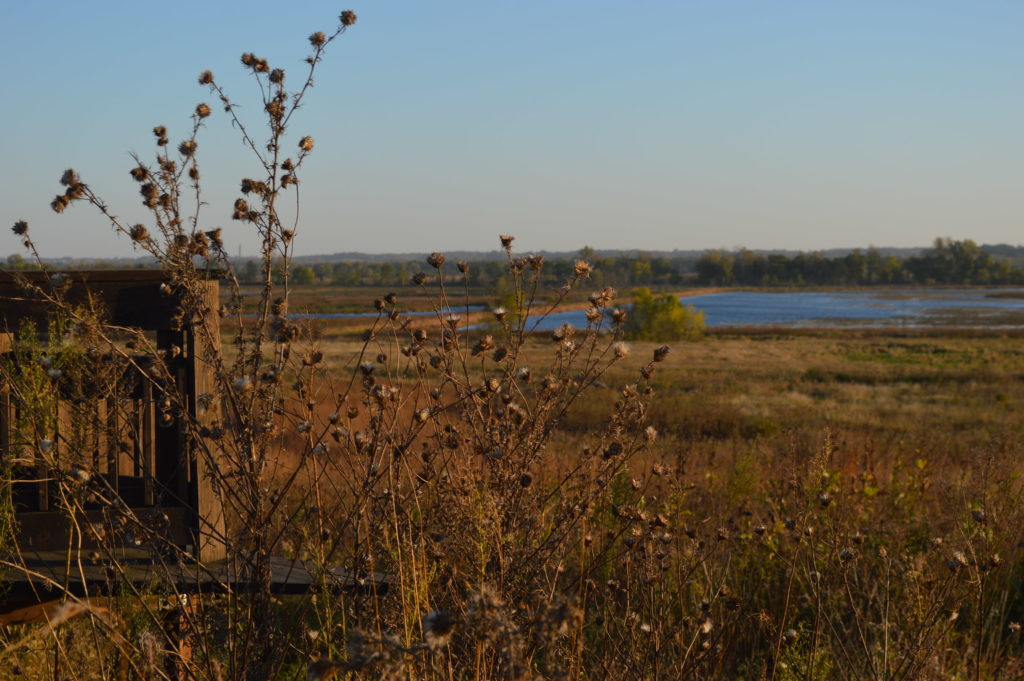
Blue-winged teal are shown at Otter Creek Marsh near Chelsea, Iowa. (photo/Iowa Department of Natural Resources)
This item about Otter Creek Marsh from the Iowa Department of Natural Resources hits close to home.
Our family’s Heritage Farm is located nearby in rural Chelsea. Recently, we had some of the farm’s bottomland enrolled in the Wetlands Reserve Program, to add to the habitat available on this “migration superhighway.”
There is nothing like the sound of sandhill cranes to bring home the importance of this wetlands area to our state.
More: Trumpeter swans back from brink of extinction in Iowa
Learn more about Otter Creek Marsh from the Iowa DNR:
Chelsea, Iowa – The viewing platform on County Road E66 can be a busy place when the annual migration is on. Looking out at the 3,800-acre Otter Creek Marsh, the platform offers an excellent view of tens of thousands of waterfowl, raptors and other birds as they zero in on this perfectly placed oasis during their journey each spring and fall.
Otter Creek Marsh Wildlife Area is a mix of wetlands, reconstructed prairie and floodplain timber in eastern Tama County that was specifically selected for development because of its species richness and location on a major migration corridor.
The 1,200-acre wetland attracts more than waterfowl, it also attracts trumpeter swans, sandhill cranes and the occasional rare visitor including common moorhens, glossy ibises, white faced ibises, swallow-tailed kite and black bellied whistling ducks and more. It’s that potential for a unique and rare encounter that causes the parking lot to spill over to the road shoulder and the viewing platform to fill with birders.
“We re-direct water flow from Otter Creek from multiple channels and control structures to create habitat for waterfowl. We do have the option to pump water from the Iowa River, but if there’s adequate water flow in the creek, it’s not necessary,” said Steve Woodruff, wildlife biologist with the Iowa Department of Natural Resources. “Habitat is our priority.”
And it shows.
The habitat diversity extends beyond supporting the waterfowl migration. Blanding’s turtles are here along with osprey and bald eagles. Some years, there’s a good tiger salamander migration into the marsh.
Creating and maintaining that habitat takes a lot of work, from keeping the network of ditches clear of debris so water can be delivered to eight wetland segments, to protecting the integrity of the dikes and removing the log jams that come down Otter Creek.
All that work pays off when habitat attracts waterfowl, and the waterfowl attracts hunters.
“When we have good water, we could have as many as 80 vehicles here – some hunters will even spend the night in the parking lot,” Woodruff said.
Hunters come from Tama and Benton counties, and Cedar Rapids, Marshalltown, Iowa City and Des Moines. Woodruff gets calls from as far away as Des Plaines, Ill., asking about water levels and duck numbers.
Otter Creek Marsh is one of the busiest areas in Woodruff’s six county Iowa River Wildlife Unit, which is pretty impressive given that it’s located in a low population area.
“It’s tradition to hunt here for a lot of people,” Woodruff said.
Trumpeter swans at Otter Creek
Otter Creek Marsh was a study area in the early days of the trumpeter swan reintroduction efforts and has played a key role in returning these charismatic mega-fauna to Iowa wetlands.
Trumpeter swans have been successfully nesting at Otter Creek for years but the nesting pairs dropped from two in 2018 to one this year, likely due to one of the swans getting shot here last year. Of all the positive happenings at Otter Creek Marsh, there is an unfortunate history of trumpeters being killed here.
Fifteen years ago, there were two swans were confirmed killed and one was suspected killed. In 2018, two swans were killed. In 2016, another one was shot. Shooting a trumpeter swan will result in a $1,500 fine and liquidated damages.
Related: More Iowans charged in trumpeter swan shootings

Otter Creek Marsh Wildlife Area is a mix of wetlands, reconstructed prairie and floodplain timber. (photo/Cindy Hadish)
“We’ve had way too many trumpeters get shot here. One of the first rules of hunting is to positively identify the target before pulling the trigger,” said Woodruff. “And we encourage hunters to report any violations they witness.”
Etcetera
Otter Creek Marsh is part of the Iowa River Bird Conservation Area, which was the first Bird Conservation Area centered on a river corridor. Hunting is not allowed in segments three and five on Otter Creek Marsh – those are refuges. Hunters also cannot shoot from the main dike channel.
Otter Creek Marsh is geared toward boats less than 16 feet long with mud motors. Hunting from a kayak or canoe is another method here on some of the more hard to get to segments. “The staff does the best possible job to create habitat for all game and non-game species, and provide the best possible recreational opportunities for visitors to enjoy,” Woodruff said.
Otter Creek Marsh was the first place in Iowa where, in 1992, sandhill cranes reproduction was documented. It was also a study area for the otter reintroduction effort and is an otter release site.
Opportunities outside of hunting include cross country skiing, hiking, bird watching, dog training (outside of nesting season – March 15 – July 15), shed antler hunting and fishing for bullheads and carp.
Barn owl boxes are placed on the marsh hoping to attract a nesting pair of the state endangered species.
More: Shot fired at deer hits Iowan cleaning her kitchen

A viewing platform at Otter Creek Marsh helps visitors see migrating birds and more. (photo/Cindy Hadish)

Otter Creek Marsh is one of the busiest areas in the six-county Iowa River Wildlife Unit. (photo/Cindy Hadish)

Land in Tama County was specifically selected because of its species richness and location on a major migration corridor. (photo/Cindy Hadish)






[…] Related: Otter Creek Marsh on migration superhighway […]